英语文具教学设计
- 格式:docx
- 大小:12.49 KB
- 文档页数:3
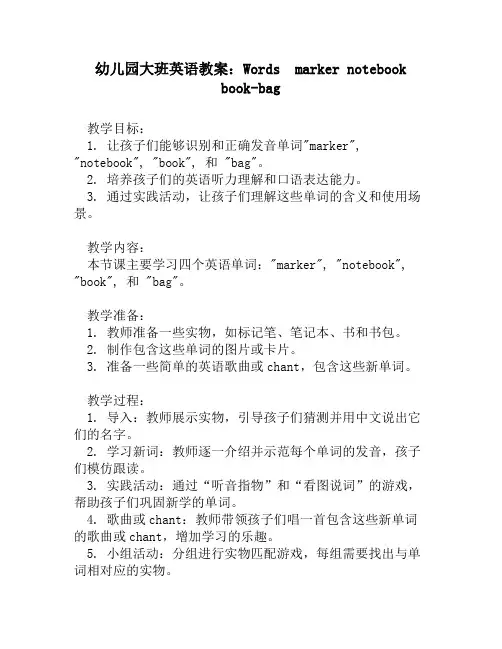
幼儿园大班英语教案:Words marker notebookbook-bag教学目标:1. 让孩子们能够识别和正确发音单词"marker", "notebook", "book", 和 "bag"。
2. 培养孩子们的英语听力理解和口语表达能力。
3. 通过实践活动,让孩子们理解这些单词的含义和使用场景。
教学内容:本节课主要学习四个英语单词:"marker", "notebook", "book", 和 "bag"。
教学准备:1. 教师准备一些实物,如标记笔、笔记本、书和书包。
2. 制作包含这些单词的图片或卡片。
3. 准备一些简单的英语歌曲或chant,包含这些新单词。
教学过程:1. 导入:教师展示实物,引导孩子们猜测并用中文说出它们的名字。
2. 学习新词:教师逐一介绍并示范每个单词的发音,孩子们模仿跟读。
3. 实践活动:通过“听音指物”和“看图说词”的游戏,帮助孩子们巩固新学的单词。
4. 歌曲或chant:教师带领孩子们唱一首包含这些新单词的歌曲或chant,增加学习的乐趣。
5. 小组活动:分组进行实物匹配游戏,每组需要找出与单词相对应的实物。
教学延伸:鼓励孩子们在日常生活中寻找和使用这四个单词,比如在家中找到标记笔、笔记本、书和书包,并尝试用英语描述它们。
教学总结:回顾本节课的学习内容,强调这四个单词的发音和含义,鼓励孩子们在日常生活中实践使用。
教学评估:1. 观察和记录孩子们在课堂活动中的参与程度和反应,评估他们的理解程度和兴趣。
2. 进行口头测试,随机提问孩子们这四个单词的发音和含义。
3. 在接下来的几天中,观察孩子们是否能在日常生活中正确使用这些新学的单词。
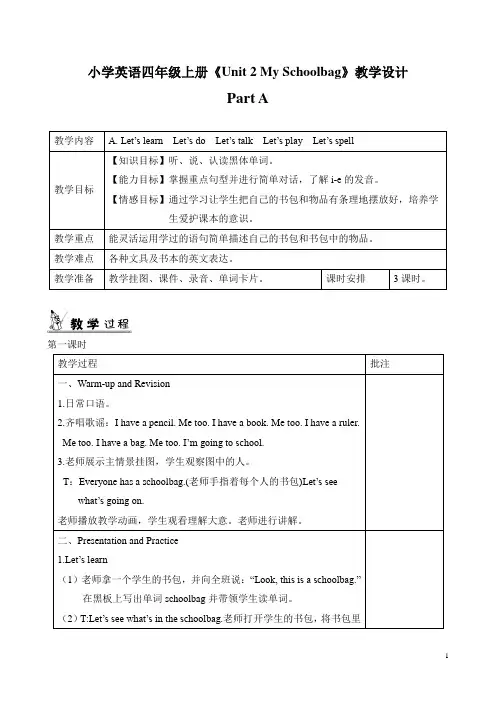
小学英语四年级上册《Unit 2 My Schoolbag》教学设计
Part A
第一课时
第二课时
第三课时
Part B
第一课时
第二课时
第三课时
教学反思
本节课上完之后,学生对该节课的知识内容掌握情况因人而异,基础好的学僧掌握很快,基础差点的学生学起来有一定的难度。
但整体上出现以下的一些情况:1.单词记不牢,学了就忘;2.单词书写情况不是很标准,有个别字母容易写错,如字母i和字母l分不清楚;3.不会结合学过的单词来运用于新句型中,不会用I have...来创造更多的句子;4.怕出错,不敢说英语,也不会用英语表达;5.听音辩词的能力不强。
针对这些问题,我采取了鼓励激发、创造情境、肢体语言的运用以及变换语调等方式来激发学生学习英语的热情,鼓励学生多说英语,多表扬,少批评。
教学中我也比较注重师生互动,并力求师生关系融洽,以营造轻松的课堂氛围。
在课堂上,我多以游戏的形式来教学和亲切的目光,轻松的表情,和蔼的态度,鼓励学生,调动他们学习的积极性,激发他们学习的兴趣,因而取得了良好的教学效果。
但是听了听课老师的评价,我发觉自己在教学中还是存在许多不足之处,比如:教学方法不够灵活多样,显得呆板,课文内容拓展很少,等等,在以后的教学中要注意改进。
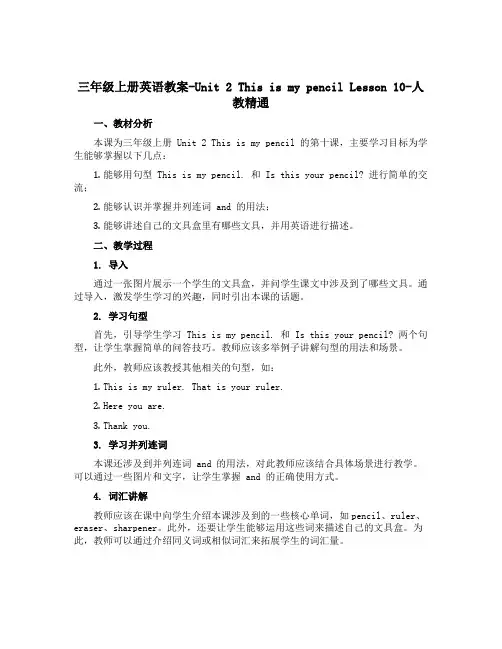
三年级上册英语教案-Unit 2 This is my pencil Lesson 10-人教精通一、教材分析本课为三年级上册 Unit 2 This is my pencil 的第十课,主要学习目标为学生能够掌握以下几点:1.能够用句型 This is my pencil. 和 Is this your pencil? 进行简单的交流;2.能够认识并掌握并列连词 and 的用法;3.能够讲述自己的文具盒里有哪些文具,并用英语进行描述。
二、教学过程1. 导入通过一张图片展示一个学生的文具盒,并问学生课文中涉及到了哪些文具。
通过导入,激发学生学习的兴趣,同时引出本课的话题。
2. 学习句型首先,引导学生学习 This is my pencil. 和 Is this your pencil? 两个句型,让学生掌握简单的问答技巧。
教师应该多举例子讲解句型的用法和场景。
此外,教师应该教授其他相关的句型,如:1.This is my ruler. That is your ruler.2.Here you are.3.Thank you.3. 学习并列连词本课还涉及到并列连词 and 的用法,对此教师应该结合具体场景进行教学。
可以通过一些图片和文字,让学生掌握 and 的正确使用方式。
4. 词汇讲解教师应该在课中向学生介绍本课涉及到的一些核心单词,如pencil、ruler、eraser、sharpener。
此外,还要让学生能够运用这些词来描述自己的文具盒。
为此,教师可以通过介绍同义词或相似词汇来拓展学生的词汇量。
5. 练习在学习完句型、连词和词汇后,教师应该让学生进行练习。
这可以通过两种方式实现:1.和同桌进行交流:让学生和同桌进行对话,练习简单的问答技巧;2.场景模拟:通过构建一些场景,让学生能够在真实的环境中应用所学内容。
6. 作业在本节课结束后,教师应该布置一些简单的作业,如默写本课涉及到的单词和句型,或者完成一些书本上的练习。
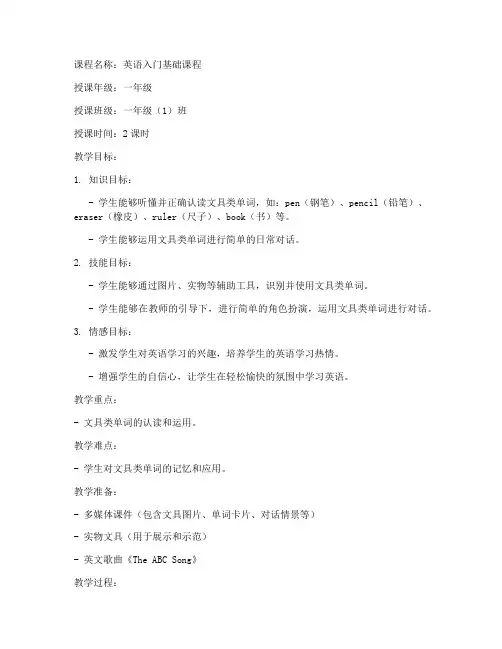
课程名称:英语入门基础课程授课年级:一年级授课班级:一年级(1)班授课时间:2课时教学目标:1. 知识目标:- 学生能够听懂并正确认读文具类单词,如:pen(钢笔)、pencil(铅笔)、eraser(橡皮)、ruler(尺子)、book(书)等。
- 学生能够运用文具类单词进行简单的日常对话。
2. 技能目标:- 学生能够通过图片、实物等辅助工具,识别并使用文具类单词。
- 学生能够在教师的引导下,进行简单的角色扮演,运用文具类单词进行对话。
3. 情感目标:- 激发学生对英语学习的兴趣,培养学生的英语学习热情。
- 增强学生的自信心,让学生在轻松愉快的氛围中学习英语。
教学重点:- 文具类单词的认读和运用。
教学难点:- 学生对文具类单词的记忆和应用。
教学准备:- 多媒体课件(包含文具图片、单词卡片、对话情景等)- 实物文具(用于展示和示范)- 英文歌曲《The ABC Song》教学过程:第一课时1. 导入(5分钟)- 播放英文歌曲《The ABC Song》,营造轻松愉快的课堂氛围。
- 引导学生复习字母表,为学习文具类单词做铺垫。
2. 新课导入(10分钟)- 展示多媒体课件中的文具图片,引导学生说出对应的英文单词。
- 通过游戏(如“猜猜看”),让学生积极参与,巩固文具类单词。
3. 单词认读(15分钟)- 教师带领学生跟读文具类单词,并纠正发音。
- 学生分组,进行单词接龙游戏,巩固单词记忆。
4. 对话练习(10分钟)- 教师创设情景,引导学生运用文具类单词进行对话。
- 学生进行角色扮演,练习日常对话。
5. 总结与作业(5分钟)- 教师总结本节课所学内容,强调文具类单词的重要性。
- 布置课后作业:让学生回家后,与家长用英语进行文具类单词的问答练习。
第二课时1. 复习导入(5分钟)- 回顾上节课所学文具类单词,进行快速问答。
- 学生展示自己的文具,并用英语介绍。
2. 拓展练习(15分钟)- 教师展示更多文具图片,引导学生说出对应的英文单词。
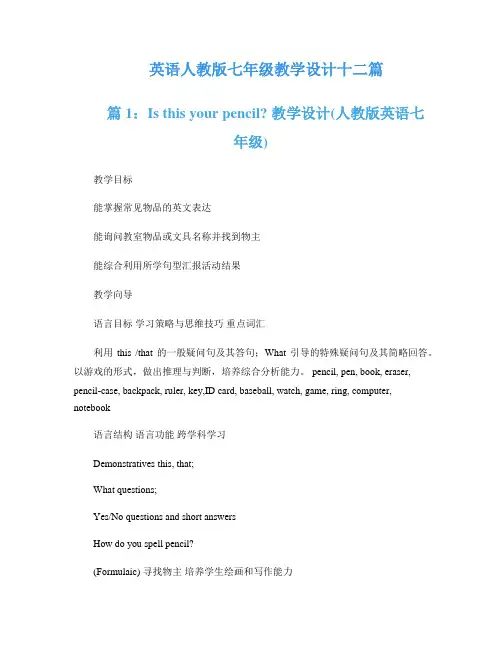
英语人教版七年级教学设计十二篇篇1:Is this your pencil? 教学设计(人教版英语七年级)教学目标能掌握常见物品的英文表达能询问教室物品或文具名称并找到物主能综合利用所学句型汇报活动结果教学向导语言目标学习策略与思维技巧重点词汇利用this /that 的一般疑问句及其答句;What 引导的特殊疑问句及其简略回答。
以游戏的形式,做出推理与判断,培养综合分析能力。
pencil, pen, book, eraser, pencil-case, backpack, ruler, key,ID card, baseball, watch, game, ring, computer, notebook语言结构语言功能跨学科学习Demonstratives this, that;What questions;Yes/No questions and short answersHow do you spell pencil?(Formulaic) 寻找物主培养学生绘画和写作能力主题词表pencil, pen, book, eraser, pencil-case, backpack, ruler, key, ID card, baseball, watch, game, ring, computer, notebookExtensive words:textbook; exercise-book; ball-pen; compass; sharpener; rubber; glue; color-pen; sticker; highlight; ball-point; scissors; chalk; file; blackboard; ink; set- square; paper; pamphlet; peg.重点句型(1)Is this your pencil? Yes, it is./No, it isn’t.(2)Is that my book? Yes, it is./ No, it isn’t.(3)Is this/that her/his eraser? Yes, it is./ No, it isn’t.(4)What’s this/ that in English? It’s a/an ……(5)How do you spell pen? P-E-N.主题思维图及任务型活动课前准备让学生收集并自学有关文具或教室物品的名词,并准备一些实物或图片。
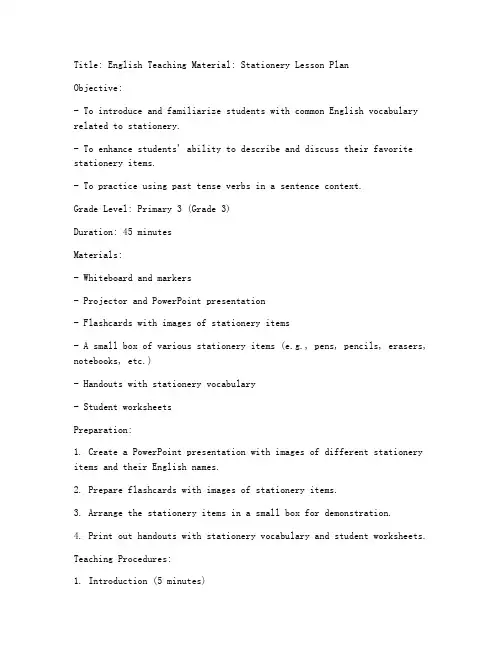
Title: English Teaching Material: Stationery Lesson PlanObjective:- To introduce and familiarize students with common English vocabulary related to stationery.- To enhance students' ability to describe and discuss their favorite stationery items.- To practice using past tense verbs in a sentence context.Grade Level: Primary 3 (Grade 3)Duration: 45 minutesMaterials:- Whiteboard and markers- Projector and PowerPoint presentation- Flashcards with images of stationery items- A small box of various stationery items (e.g., pens, pencils, erasers, notebooks, etc.)- Handouts with stationery vocabulary- Student worksheetsPreparation:1. Create a PowerPoint presentation with images of different stationery items and their English names.2. Prepare flashcards with images of stationery items.3. Arrange the stationery items in a small box for demonstration.4. Print out handouts with stationery vocabulary and student worksheets.Teaching Procedures:1. Introduction (5 minutes)- Greet the students and ask them to share what they have in their desks.- Introduce the theme of the lesson: "Stationery."- Show the PowerPoint presentation to introduce the vocabulary and images of stationery items.2. Vocabulary Introduction (10 minutes)- Point to each stationery item on the PowerPoint and ask students to repeat the English name.- Use the flashcards to reinforce the vocabulary.- Write the stationery words on the board and ask students to read them aloud.3. Group Activity: Stationery Sort (10 minutes)- Divide the class into small groups.- Give each group a set of stationery items.- Instruct students to sort the items into categories based on their names.- Each group will report back to the class, naming the categories and explaining their choices.4. Speaking Practice: My Favorite Stationery (10 minutes)- Hand out student worksheets with blanks for the stationery vocabulary.- Instruct students to write a short paragraph describing their favorite stationery item.- Have students share their paragraphs with a partner or the whole class.5. Grammar Practice: Past Tense Verbs (10 minutes)- Introduce the past tense of common verbs used in relation tostationery (e.g., bought, used, wrote).- Use examples on the board to demonstrate how to form the past tense.- Have students practice forming the past tense of verbs in small groups.- Ask students to create sentences using the past tense verbs related to their favorite stationery item.6. Conclusion (5 minutes)- Review the stationery vocabulary and the past tense verbs used in the lesson.- Ask students to write down one new word they learned and use it in a sentence.- Thank the students for their participation and close the lesson. Assessment:- Observe students' participation in activities and their ability to use the new vocabulary and grammar.- Collect the student worksheets to assess their writing and grammar usage.- Hold a short quiz at the end of the lesson to test their recall of the new vocabulary and past tense verbs.Note: This template can be adapted to different grade levels and teaching styles. Adjust the complexity of activities and vocabulary according to the needs of your students.。
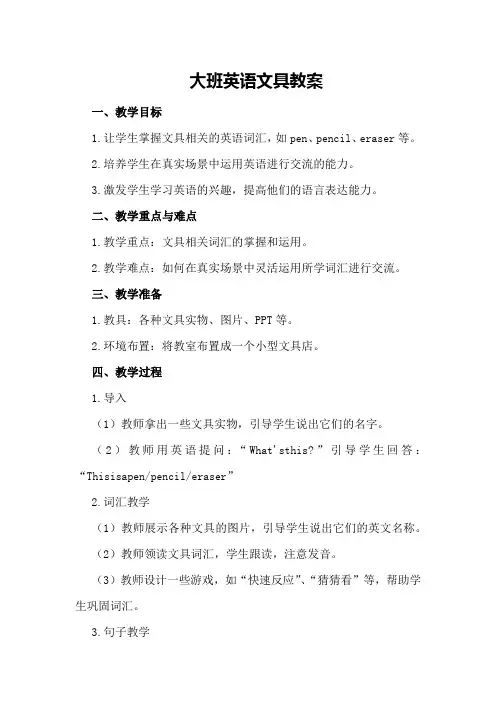
大班英语文具教案一、教学目标1.让学生掌握文具相关的英语词汇,如pen、pencil、eraser等。
2.培养学生在真实场景中运用英语进行交流的能力。
3.激发学生学习英语的兴趣,提高他们的语言表达能力。
二、教学重点与难点1.教学重点:文具相关词汇的掌握和运用。
2.教学难点:如何在真实场景中灵活运用所学词汇进行交流。
三、教学准备1.教具:各种文具实物、图片、PPT等。
2.环境布置:将教室布置成一个小型文具店。
四、教学过程1.导入(1)教师拿出一些文具实物,引导学生说出它们的名字。
(2)教师用英语提问:“What'sthis?”引导学生回答:“Thisisapen/pencil/eraser”2.词汇教学(1)教师展示各种文具的图片,引导学生说出它们的英文名称。
(2)教师领读文具词汇,学生跟读,注意发音。
(3)教师设计一些游戏,如“快速反应”、“猜猜看”等,帮助学生巩固词汇。
3.句子教学(1)教师展示一些含有文具词汇的句子,如:“Ihaveapen.”、“Thisismypencil.”等,引导学生模仿。
(2)教师设计一些情境,让学生在真实场景中运用所学句子进行交流,如:“你想借我的笔吗?”、“这是你的橡皮吗?”等。
4.情景演练(1)教师将学生分成小组,每组选出一个“顾客”和“店员”。
(2)教师给出一些任务,如:“顾客”要买一支笔,“店员”要询问“顾客”需要什么文具。
(3)学生在小组内进行情景演练,教师巡回指导。
(1)教师邀请一些小组进行展示,让他们用英语介绍自己购买的文具。
(2)教师对学生的表现进行评价,鼓励他们继续努力。
6.作业布置(1)让学生用英语写一篇关于自己最喜欢的文具的短文。
(2)让学生与家长一起用英语介绍家里的文具,并录制视频。
五、课后反思1.教师要关注每个学生的学习进度,对学习有困难的学生给予个别辅导。
2.在教学过程中,教师要注重激发学生的学习兴趣,让他们在轻松愉快的氛围中学习英语。
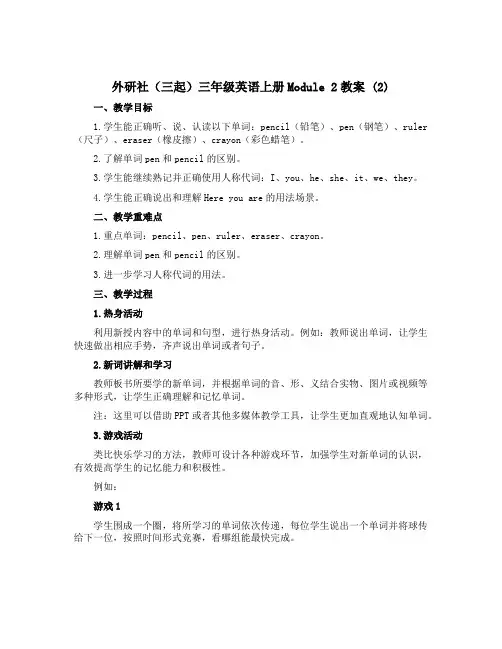
外研社(三起)三年级英语上册Module 2教案 (2)一、教学目标1.学生能正确听、说、认读以下单词:pencil(铅笔)、pen(钢笔)、ruler (尺子)、eraser(橡皮擦)、crayon(彩色蜡笔)。
2.了解单词pen和pencil的区别。
3.学生能继续熟记并正确使用人称代词:I、you、he、she、it、we、they。
4.学生能正确说出和理解Here you are的用法场景。
二、教学重难点1.重点单词:pencil、pen、ruler、eraser、crayon。
2.理解单词pen和pencil的区别。
3.进一步学习人称代词的用法。
三、教学过程1.热身活动利用新授内容中的单词和句型,进行热身活动。
例如:教师说出单词,让学生快速做出相应手势,齐声说出单词或者句子。
2.新词讲解和学习教师板书所要学的新单词,并根据单词的音、形、义结合实物、图片或视频等多种形式,让学生正确理解和记忆单词。
注:这里可以借助PPT或者其他多媒体教学工具,让学生更加直观地认知单词。
3.游戏活动类比快乐学习的方法,教师可设计各种游戏环节,加强学生对新单词的认识,有效提高学生的记忆能力和积极性。
例如:游戏1学生围成一个圈,将所学习的单词依次传递,每位学生说出一个单词并将球传给下一位,按照时间形式竞赛,看哪组能最快完成。
游戏2每组学生选出一名代表,手持单词卡,根据教师提出的单词解释汉语意思,而其他组学生要猜出单词。
游戏3学生按照教师给出的单词表格,两人一组展开对话互换学习单词的方法。
4.巩固活动为了加强新学单词、句型、流利地说出单句和简短对话的能力,在不断地学习生活中加强巩固活动的方法显得尤为关键。
在巩固的过程中,学生要反复练习句子,要求能够说出完整的句意。
例如,教师针对学生熟悉的Here you are的用法场景,让学生意识到Here you are的场景不仅限于交换物品的情况,例如在餐馆用餐时,可以使用Here you are or Enjoy your meal。
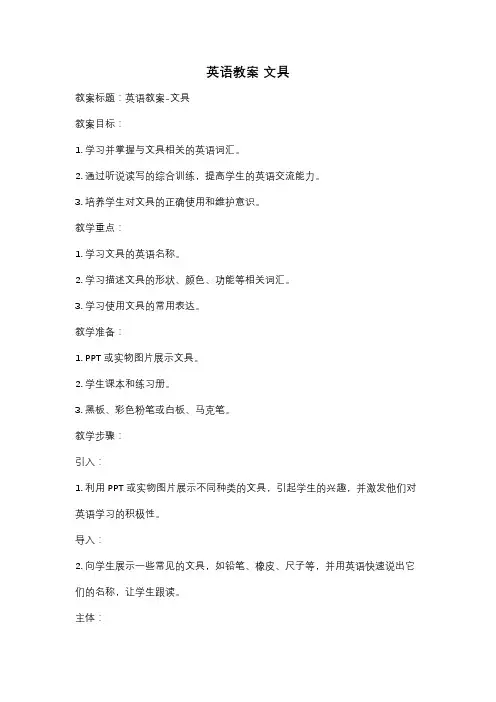
英语教案文具教案标题:英语教案-文具教案目标:1. 学习并掌握与文具相关的英语词汇。
2. 通过听说读写的综合训练,提高学生的英语交流能力。
3. 培养学生对文具的正确使用和维护意识。
教学重点:1. 学习文具的英语名称。
2. 学习描述文具的形状、颜色、功能等相关词汇。
3. 学习使用文具的常用表达。
教学准备:1. PPT或实物图片展示文具。
2. 学生课本和练习册。
3. 黑板、彩色粉笔或白板、马克笔。
教学步骤:引入:1. 利用PPT或实物图片展示不同种类的文具,引起学生的兴趣,并激发他们对英语学习的积极性。
导入:2. 向学生展示一些常见的文具,如铅笔、橡皮、尺子等,并用英语快速说出它们的名称,让学生跟读。
主体:3. 教师通过PPT或黑板上展示文具图片,逐个介绍文具的名称,并帮助学生正确发音和记忆。
同时,教师可以用简单的英语句子描述文具的形状、颜色和功能,引导学生学习相关词汇。
例如:- This is a pencil. It's long and thin. It's yellow.- This is a ruler. It's straight and long. It's transparent.4. 学生跟读教师的发音,并进行口头练习,描述展示的文具。
教师可提供一些问题,引导学生运用所学词汇进行回答。
例如:- What color is the pencil?- Is the ruler long or short?5. 学生根据教师的指导,完成练习册上的相关练习,巩固所学内容。
拓展:6. 学生分组进行角色扮演,模拟购买文具的场景。
一名学生扮演店员,另一名学生扮演顾客,通过英语进行交流,购买所需的文具。
教师可以提供一些常用的购物对话,帮助学生进行对话练习。
总结:7. 教师对本节课的内容进行总结,并提醒学生在日常生活中正确使用和维护文具的重要性。
作业:8. 布置作业,要求学生用英语写一篇关于自己最喜欢的文具的作文,包括文具的名称、形状、颜色和功能等。
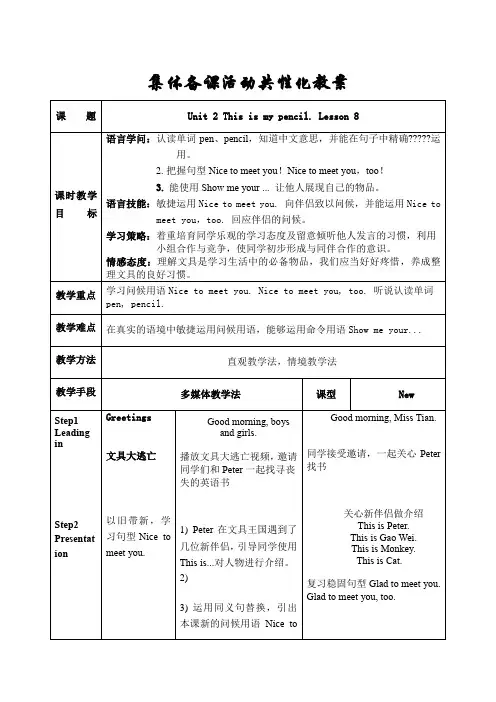
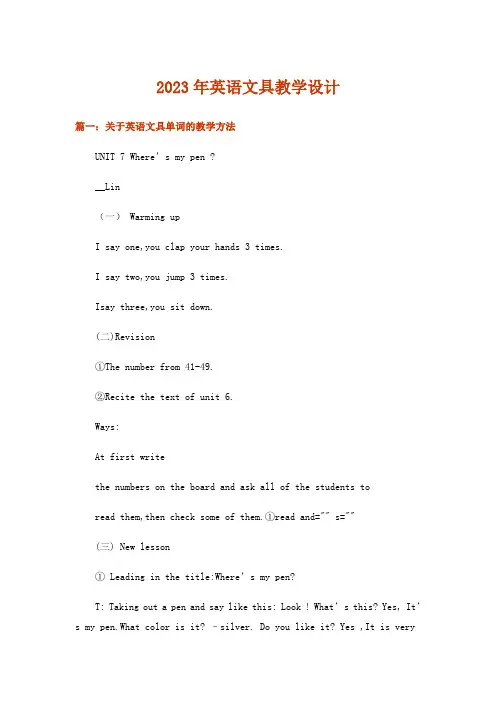
2023年英语文具教学设计篇一:关于英语文具单词的教学方法UNIT 7 Where’s my pen ?__Lin(一) Warming upI say one,you clap your hands 3 times.I say two,you jump 3 times.Isay three,you sit down.(二)Revision①The number from 41-49.②Recite the text of unit 6.Ways:At first writethe numbers on the board and ask all of the students toread them,then check some of them.①read and="" s=""(三) New lesson① Leading in the title:Where’s my pen?T: Taking out a pen and say like this: Look ! What’s this? Yes, It’s my pen.What color is it? –silver. Do you like it? Yes ,It is verynice.Then tell students: I’m a magician魔术师.Look carefully and answer: Where’s my pen?I’s on/in/under/behind/next to…② Learn and practice the new wordsWays: Explaining/reading/making sentences③Learn the textWays: ①Listen and answer1.What happened about lucy and Karen?2.Whose old pencil-case is it?②Read and recite it sentence by sentence逐句③ Practice△ Read in different actors.△ Important sentences.重点句子背诵并能举一反三(四)小结本课教学目标及达标联系检测。
Objective:To introduce students to basic English vocabulary related to stationery and to provide them with a basic understanding of how to use these words in simple sentences.Grade Level: Primary (Grade 3-4)Subject: English Language ArtsDuration: 1 hourMaterials:- Whiteboard and markers- Handouts with pictures of stationery items- Flashcards with stationery items- Pencils, pens, and paper for each student- Colored markers for coloring activities- Chalkboard or whiteboard- TimerLesson Plan:I. Introduction (10 minutes)1. Greet and Introduction:- Greet the students and introduce the topic of the lesson: "Today, we are going to learn about stationery."2. Review of Previous Knowledge:- Ask the students if they can name any stationery items they use. List their responses on the board.3. Purpose of the Lesson:- Explain that they will learn new words related to stationery and how to use them in sentences.II. Vocabulary Introduction (15 minutes)1. Show and Tell:- Display a variety of stationery items (e.g., pencils, pens, notebooks, erasers) and ask students to guess what they are in English.2. Vocabulary Teaching:- Introduce each stationery item with its English name, using pictures or flashcards for visual support.- Use simple sentences to demonstrate the use of each word:- "This is a pencil. It's used for writing."- "A pen is for writing, too. It has ink."- "A notebook is where you write your notes."- "An eraser is used to correct mistakes."3. Practice:- Have students repeat the words after you.- Use a simple sentence structure like "I have a ... (stationery item)" and ask students to fill in the blank with the correct item.III. Activity: Coloring and Labeling (15 minutes)1. Prepare Handouts:- Provide each student with a handout that contains pictures of different stationery items.2. Coloring Activity:- Instruct students to color the pictures of the stationery items.- As they color, they can practice saying the names of the items in English.3. Labeling Activity:- After coloring, ask students to label each picture with the correct English word.- Circulate around the classroom to assist and correct any mistakes.IV. Consolidation and Review (10 minutes)1. Group Activity:- Divide the class into small groups.- Each group gets a set of stationery items and a piece of paper.- Instruct the groups to create a simple "stationery store" by drawing and labeling the items on their paper.2. Whole-Class Review:- Bring the groups back together and have each group present their "stationery store" to the class.- Encourage other students to ask questions and use the new vocabulary.V. Conclusion (5 minutes)1. Recap:- Go over the main vocabulary items from the lesson.- Ask students to repeat the words and use them in simple sentences.2. Homework Assignment:- Assign students to bring in a favorite stationery item from home and describe it to their classmates in English the next day.Assessment:- Observe student participation during the vocabulary introduction and activities.- Check the completed handouts for correct labeling of stationery items.- Assess the quality of the "stationery store" presentations in the final。
文具和办公用品的英文教学教案Title: English Lesson Plan for Teaching Stationery and Office SuppliesObjective:By the end of this lesson, students will be able to identify and name common stationery and office supplies in English and use them in context.Level: IntermediateTime: 60 minutesMaterials:- Pictures or flashcards of various stationery and office supplies- Whiteboard or blackboard- Marker or chalk- Worksheets (one per student)- Scissors- GlueProcedure:1. Warm-up (5 minutes)- Greet the students and create a context for the lesson by asking questions related to stationery and office supplies.- Show pictures or flashcards of stationery and office supplies and ask students to name them in English.- Write down the names of the items on the board.2. Vocabulary Introduction (10 minutes)- Divide the board into two columns: "Stationery" and "Office Supplies."- Point to each item on the board and ask students to categorize them accordingly.- Clarify any unknown vocabulary and pronunciation.3. Presentation (15 minutes)- Show the pictures or flashcards of stationery and office supplies again.- Pronounce each word clearly and ask students to repeat after you.- Write the names of the items in English on the board and elicit the correct spelling for each word.- Drill the pronunciation and spelling.4. Practice Activities (20 minutes)Activity 1: Matching Exercise- Distribute the worksheets to students.- Instruct students to match the pictures of stationery and office supplies with their corresponding names.- Monitor the students and provide assistance when needed.Activity 2: Sentence Completion- Provide the students with sentences that are missing the names of the stationery or office supplies.- Instruct students to fill in the blanks with the correct words from the given list.- Encourage students to use the words in context.Activity 3: Role Play- Divide the class into pairs or small groups.- Assign a role to each group, such as a customer and a store clerk.- Instruct students to create a dialogue using the stationery and office supplies vocabulary.- Model a dialogue with a student for better understanding.5. Production (10 minutes)- Ask volunteers to perform their role play dialogues in front of the class.- Provide feedback and encourage other students to participate.6. Review and Closure (5 minutes)- Review the vocabulary by pointing to each item on the board and asking students to say the correct word.- Summarize what students have learned in the lesson.- Thank the students for their participation and effort.Note: It is essential to adapt and modify this lesson plan according to the specific needs and abilities of your students.。
课时: 2课时教学目标:1. 学生能够识别并正确使用常见的文具英文名称。
2. 学生能够用英语描述文具的功能和用途。
3. 学生能够在日常生活中运用所学词汇进行简单的交流。
教学对象:小学三年级教学重点:- 文具的英文名称- 文具的基本用途教学难点:- 文具英文名称的发音- 结合情境使用文具词汇教学准备:- 教学PPT或黑板- 文具实物或图片- 音频资料(文具英文名称的发音)- 作业纸教学过程:第一课时一、导入(5分钟)1. 老师出示一些文具实物,如铅笔、橡皮、尺子等,让学生观察并说出它们的名称。
2. 引导学生思考:这些文具在英语中是如何称呼的?二、新课学习(20分钟)1. 词汇学习:- 在PPT或黑板上展示文具的英文名称和对应的图片,如pencil(铅笔)、eraser(橡皮)、ruler(尺子)等。
- 通过游戏或小组活动,让学生重复发音,并尝试用英语描述这些文具。
2. 情境对话:- 老师示范一个简单的文具使用情境对话,如:“Can I borrow your pencil?I need to write down some notes.”- 让学生分成小组,模仿老师的对话进行练习。
3. 角色扮演:- 分配角色,如学生、老师、同学等,模拟一个文具店购物的场景,让学生用英语询问和回答。
三、巩固练习(10分钟)1. 单词卡片游戏:- 制作或使用现成的单词卡片,让学生进行匹配游戏,巩固文具词汇。
2. 句子接龙:- 学生轮流用文具词汇造句,如:“I have a new ruler.” 然后下一个学生继续:“I need a pencil to write.”四、总结(5分钟)- 老师带领学生回顾本节课所学的内容,强调文具英文名称的发音和用法。
第二课时一、复习(5分钟)1. 老师通过提问的方式,检查学生对文具英文名称的记忆情况。
二、拓展练习(20分钟)1. 故事接龙:- 学生分成小组,每组选择一个文具作为故事的开头,如“Once upon a time, there was a pencil...”,然后轮流接龙,使故事更加完整。
一、教学目标1. 知识目标:掌握文具的英语单词,如pen、pencil、eraser、ruler、sharpener等。
2. 能力目标:能够运用文具单词进行简单的对话交流。
3. 情感目标:激发学生对英语学习的兴趣,培养学生良好的学习习惯。
二、教学重点与难点1. 教学重点:文具单词的认读和运用。
2. 教学难点:文具单词的拼写和运用。
三、教学过程(一)导入1. 教师出示各种文具,引导学生说出文具的名称。
2. 教师用英语介绍文具,如:"This is a pen. This is a pencil. This is an eraser. This is a ruler. This is a sharpener."(二)新课呈现1. 教师带领学生一起学习文具单词,并让学生跟读。
2. 学生分组进行文具单词接龙游戏,巩固所学单词。
(三)巩固练习1. 教师出示图片,让学生用所学单词描述图片中的文具。
2. 学生两人一组,用文具单词进行对话练习。
(四)拓展活动1. 教师展示一组关于文具的英语短文,让学生阅读并回答问题。
2. 学生发挥想象力,用所学单词和句型编写一个小故事。
(五)总结与作业1. 教师对本节课所学内容进行总结,强调重点单词和句型。
2. 课后作业:让学生回家后,用所学单词和句型向家长介绍自己的文具。
四、教学反思1. 本节课通过多种教学活动,帮助学生掌握了文具单词,提高了学生的英语口语表达能力。
2. 在教学过程中,注重激发学生的学习兴趣,让学生在轻松愉快的氛围中学习。
3. 在课后作业的设计上,注重培养学生的实际运用能力,让学生在日常生活中运用所学知识。
关于文具的英语教案指导一、教学内容1. 文具词汇的学习:如pencil, pen, ruler, eraser, sharpener等;2. 文具相关句型的运用:如What's this? It's a ;I need a 等;3. 实践情景对话:文具店购物场景。
二、教学目标1. 掌握基本的文具词汇,并能熟练运用;2. 学会使用文具相关的英语句型进行简单交流;3. 提高学生英语听说能力,培养其运用英语解决问题的能力。
三、教学难点与重点1. 教学难点:文具词汇的发音以及相关句型的运用;2. 教学重点:文具词汇的掌握和实践情景对话的运用。
四、教具与学具准备1. 教具:PPT、黑板、录音机、磁带;2. 学具:英语教材、文具实物、练习本。
五、教学过程1. 导入:展示文具实物,引导学生用英语说出各种文具的名称,回顾已学过的文具词汇;2. 呈现:通过PPT展示新学的文具词汇,教授单词发音,让学生模仿并跟读;3. 练习:设计文具店购物场景,让学生分角色进行对话练习;4. 讲解:针对对话中出现的句型进行详细讲解,如What's this? It's a ;I need a 等;5. 应用:设置实践情景,让学生运用所学文具词汇和句型进行交流;6. 巩固:进行随堂练习,检查学生对文具词汇和句型的掌握情况;六、板书设计1. 文具词汇:pencil, pen, ruler, eraser, sharpener等;2. 文具相关句型:What's this? It's a ;I need a 等;3. 实践情景对话:文具店购物场景。
七、作业设计1. 作业题目:(1)抄写并背诵本节课所学的文具词汇;(2)运用所学句型,编写一段文具店购物对话;(3)完成课后练习册的相关习题。
答案:(1)略;(2)例:A: What's this? B: It's a pen.A: How much is it? B: It's 10 yuan.A: I need a blue pen, please. B: Here you are.(3)略。
外研版(三起)(2024)三年级上册英语Unit 2 My school things 教学设计一、教学目标知识与技能:学生能够听、说、认读并初步运用词汇:pen, pencil, ruler, eraser, book, bag, school。
学生能够用简单的句子描述自己的文具用品,如:I have a pen. This is my book.学生能理解并运用本单元的基本句型进行日常交流,表达对文具用品的喜好或询问。
过程与方法:通过实物展示、图片辅助等直观教学手段,帮助学生理解和记忆词汇。
采用游戏、歌曲、对话练习等多种教学方法,激发学生的学习兴趣和参与度。
引导学生通过观察、模仿、实践,逐步掌握英语表达能力。
情感态度与价值观:培养学生的观察力和表达欲,鼓励学生积极分享自己的学习和生活体验。
增强学生的环保意识,引导学生珍惜文具用品,合理使用资源。
激发学生对英语学习的热情,培养自主学习和合作学习的习惯。
二、教学内容分析本单元主题为“My school things”,围绕学生日常使用的文具用品展开,主要内容包括文具用品的词汇学习、简单句型的运用以及描述个人文具用品的能力培养。
通过本单元的学习,学生将能够用英语介绍自己的文具,并初步形成用英语表达个人物品的习惯。
三、学情分析三年级学生已经具备了一定的英语基础,能够听懂简单的英语指令,但词汇量有限,语法知识尚不扎实。
他们喜欢直观、生动的教学内容,对游戏、歌曲等趣味性强的活动充满兴趣。
因此,在教学中应注重词汇的直观展示和句型的情景模拟,通过多样化的教学活动激发学生的学习兴趣和积极性。
四、教学方法与手段直观教学法:利用实物、图片等直观教具展示文具用品,帮助学生建立词汇与实物之间的联系。
游戏互动法:设计“文具接龙”、“快速找文具”等游戏,让学生在游戏中巩固词汇和句型。
情景模拟法:通过模拟文具店购物、文具介绍等情景,让学生在真实或模拟的语境中运用所学语言。
多媒体辅助教学:利用音频、视频等多媒体资源,丰富教学手段,提高教学效果。
英语文具教学设计
英语文具教学设计
篇一:关于英语文具单词的教学方法
摘要语言学习本身是较为单调枯燥的,一味以教师讲、学生听这种教学形式,势必使学生学习兴趣荡然无存。
教师要遵循学生的认知规律,寓教于乐,探索激发学生求知欲的教学方法,促进学生学习单词。
关键词文具单词教学方法多样化
牛津小学英语多册书中都涉及到有关文具单词的教学。
简单的单词,机械的教读,一定枯燥乏味,费时低效。
若要学生们乐意学、学得快、记得牢、运用熟练,老师可采取多样化的教学法,促使学生听觉、发音动觉、视觉与书写动觉共同参与学习。
本人根据多年的教学实践,总结了以下几种教法:
一、在唱歌中学文具单词
唱歌,是孩子们最喜欢的一种娱乐形式。
学唱英语歌曲记英语单词,学生兴趣盎然。
而且小学英语课本上的英语歌曲琅琅上口,一旦学会便永久难忘。
我在教学3a学习用品时,我先让学生唱了1a学过的`歌曲《apencil》,复习了已学过的bag,pen,pencil和pencilbox四个单词。
继而让学生用这首歌的旋律伴奏编唱新学的
arubber,abook,aruler和apencilsharpener四个单词,强化了对单词的记忆,效果尤佳。
二、运用实物学文具单词
实物是创设情景最直接、最经济和最有效的手段。
它能使英语课篇二:小学英语—文具类单词教学优秀教案分享
UNIT7Where’smypen?
__Lin
(一)Warmingup
Isayone,youclapyourhands3times.
Isaytwo,youjump3times.
Isaythree,yousitdown.
(二)Revision
①Thenumberfrom41-49.
②Recitethetextofunit6.
Ways:
Atfirstwrite
thenumbersontheboardandaskallofthestudentsto
readthem,thenchecksomeofthem.
(三)Newlesson
①Leadinginthetitle:Where’smypen?
T:Takingoutapenandsaylikethis:Look!What’sthis?Yes,It’smyp
en.Whatcolorisit?–silver.Doyoulikeit?Yes,Itisvery nice.
Thentellstudents:I’mamagician.Lookcarefullyandanswer:Where ’smypen?
I’son/in/under/behind/nextto…
②Learnandpracticethenewwo rds
Ways:Explaining/reading/makingsentences
③Learnthetext
Ways:①Listenandanswer
1.WhathappenedaboutlucyandKaren?
2.Whoseoldpencil-caseisit?
②Readandreciteitsentencebysentence③Practice
△Readindifferentactors.
△Importantsentences.
(四)小结本课教学目标及达标联系检测。